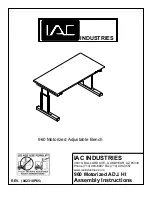
subsystems
An subsystem is a set of disk drives that are logically grouped together by the controllers in a storage
subsystem. After you create an subsystem, you can create one or more logical drives in the subsystem.
An subsystem is identified by a sequence number that is defined by the controller firmware when you
created the subsystem.
Note:
You can give a unique name to an subsystem if your Storage Manager version is 10.77 or later
with controller firmware version 7.77.xx.xx or later.
To create an subsystem, you must define the capacity and the RAID level.
Capacity is the size of the subsystem. Capacity is determined by the number of disk drives that you
assign to the subsystem. You can use only unassigned disk drives to create an subsystem. (In this
programming guide, the storage space on unassigned disk drives constitutes the
unconfigured capacity
of a
storage subsystem.)
Free capacity
is a contiguous region of unassigned capacity in a designated subsystem. Before you create a
new logical drive in an subsystem, you need to know the free capacity space so that you can determine
the size of the logical drive.
The number of disk drives you can include in an subsystem is constrained by the capacity of each disk
drive. the following table relates the capacity of individual disk drives to the number of disk drives that
you can include in an subsystem.
Table 4-3. Maximum Number of Disk Drives in an subsystem Based on Capacity
Controller firmware PRIOR to 7.10
(DS4000) or 6.xx (DS3000)
Controller firmware 7.10 or later (DS3000 /
DCS3700 / DCS3700 storage subsystem with
Performance Module Controllers / DS4000 /
DS5000 only)
Number of drives per
subsystem
30 for all RAID levels
v
RAID 3 and RAID 5:
30 drives
v
RAID 0 and RAID 1:
Maximum of drives
supported for a given storage subsystem
Maximum logical drive
size
2 TB
Number of drives in an subsystem multiplied
by the size of the smallest capacity drive in
the subsystem
Disk Pools
About disk pools
A disk pool is a set of disk drives that is logically grouped together in the storage subsystem. The disk
drives in each disk pool must be of the same drive type and drive media type, and they must be similar
in size. As with an subsystem, you can create one or more logical drives in the disk pool. However, the
disk pool is different from the logical drive group in the way that the data is distributed across the disk
drives that comprise the disk pool.
In an subsystem, the data is distributed across the disk drives based on a RAID level. You can specify the
RAID level when you create the subsystem. The data for each logical drive is written sequentially across
the set of disk drives in the subsystem.
In a disk pool, the storage management software distributes the data for each logical drive randomly
across a set the disk drives in the disk pool. Each disk pool must have a minimum of eleven disk drives.
Although there is no limit on the maximum number of disk drives that can comprise a disk pool, the
disk pool cannot contain more disk drives than the maximum limit for each storage subsystem. The
4-10
IBM System Storage DS3000, DS4000, and DS5000: Command Line Interface and Script Commands Programming Guide
Summary of Contents for System Storage DS3000
Page 599: ...Appendix A Examples of information returned by the show commands A 3...
Page 601: ...Appendix A Examples of information returned by the show commands A 5...
Page 603: ...Appendix A Examples of information returned by the show commands A 7...
Page 605: ...Appendix A Examples of information returned by the show commands A 9...
Page 607: ...Appendix A Examples of information returned by the show commands A 11...
Page 609: ...Appendix A Examples of information returned by the show commands A 13...
Page 611: ...Appendix A Examples of information returned by the show commands A 15...
Page 623: ...Appendix A Examples of information returned by the show commands A 27...
Page 625: ...Appendix A Examples of information returned by the show commands A 29...
Page 627: ...Appendix A Examples of information returned by the show commands A 31...
Page 651: ......
Page 652: ...Part Number 00W1466 Printed in USA GA32 0961 05 1P P N 00W1466...
















































